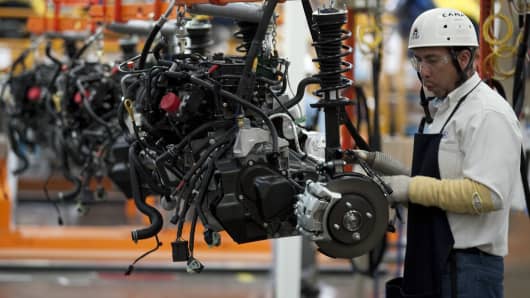And, rather than adopt strong labor and environmental provisions that would actually raise wages and standards for workers in all three countries, the plan includes the same failed labor and environmental provisions included in the TPP and previous deals. That means that labor violations – like wage theft, excessive forced overtime and even child labor violations - can't be addressed unless they are committed "in a manner affecting trade," an impossible standard to meet.
Trade deals like NAFTA have been nothing but a string of broken promises for working families. The 200,000 jobs NAFTA was supposed to create instead morphed into 700,000 jobs lost and stagnant wages for the jobs that remained.
Here's what a better NAFTA looks like:
- It eliminates the incentives that corporations now have to send jobs offshore. Current trade deals give special protections to multinational corporations operating overseas and enable them to pay wages that are a fraction of U.S. wages. Millions of U.S. manufacturing and service sector jobs, including call centers and information technology, have been lost as companies look for places to pay the lowest wages.
- It eliminates the ISDS process. ISDS allows foreign investors and multinationals to challenge local, state and federal laws before a private panel of corporate lawyers, instead of in a country's court system. The private panel decides if a corporation's "expected future profits" would be harmed by the government action being challenged, and if so, the panel assesses its often multi-million dollars fines against the government. Decisions can't be appealed. The game is rigged.This system needs to be scrapped to make sure that corporate rights don't have more priority than citizens' rights.
- It strengthens the side treaties on labor and environment and includes them as part of the overall agreement. International labor standards covering workers' rights to unionize, the prohibition of child labor and requirements for fair pay must be enforced, not ignored. Weak protections for workers and the environment that aren't enforced will not get the job done—we need strong protections and the same enforcement mechanisms available for others, including investors.
- It takes action on currency manipulation and creates binding rules that can be enforced with sanctions when necessary. Mexico devalued its currency to make imports from Mexico far cheaper than they would have been. China, Japan, and other countries have engaged in currency manipulation for years, hurting U.S. workers. That must stop. The Trump plan mentions currency manipulation, but doesn't lay out any specifics on how we'd put an end to this harmful cheating.
- It makes certain that "Buy American" means something, and actually benefits U.S. workers and communities. "Buy American" policies encourage taxpayer-funded U.S. government contracts to be awarded to U.S. workers and businesses. NAFTA created loopholes in these requirements, allowing many Mexican and Canadian products to be considered equivalent to U.S. products. An ideal renegotiated NAFTA ends this double standard.
- It reverses current provisions that drive up the costs of medicine in the U.S. by giving big pharmaceutical firms monopoly protections. That means years of delay in the development of generic drugs that ordinary people in all three countries can afford. We must reverse current policy that undermines food safety by classifying meat and other food from NAFTA partners as "equivalent" to U.S. standards, even though the products haven't gone through our food inspection process.
Commentary by Chris Shelton, president of the 700,000 member Communications Workers of America, representing workers in telecommunications, media, airlines, public service, health care and manufacturing.
For more insight from CNBC contributors, follow @CNBCopinion on Twitter.





